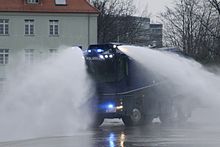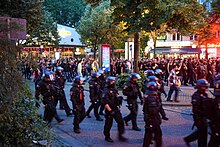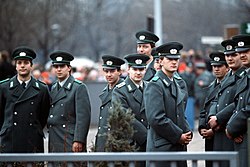
The Slovenian Armed Forces or Slovenian Army are the armed forces of Slovenia. Since 2003, it is organized as a fully professional standing army. The Commander-in-Chief of the SAF is the President of the Republic of Slovenia, while operational command is in the domain of the Chief of the General Staff of the Slovenian Armed Forces.

The German Army is the land component of the armed forces of Germany. The present-day German Army was founded in 1955 as part of the newly formed West German Bundeswehr together with the Marine and the Luftwaffe. As of January 2022, the German Army had a strength of 62,766 soldiers.
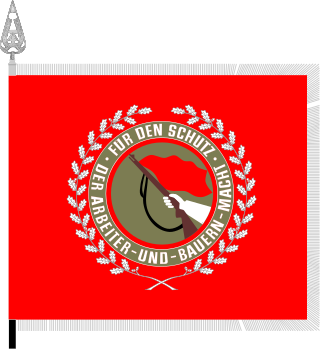
The Combat Groups of the Working Class was a paramilitary organization in the German Democratic Republic (GDR) from 1953 to 1989.
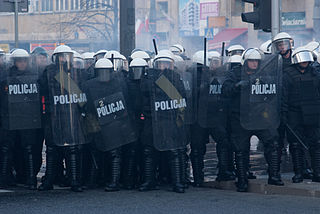
Riot police are police who are organized, deployed, trained or equipped to confront crowds, protests or riots.

The Federal Police is the national and principal federal law enforcement agency of the German Federal Government, being subordinate to the Federal Ministry of the Interior, Building and Community. The Federal Police is primarily responsible for border protection and railroad and aviation/air security. In addition, the agency is responsible, among other tasks, for the protection of federal constitutional bodies. It provides the federal alert police and GSG 9 special police unit, which can also be used to support the federated states of Germany. Ordinary police forces, meanwhile, are under the administration of the individual German states (Bundesländer) and are known as the Landespolizei. In addition to the Federal Police, the Federal Criminal Police Office and the German Parliament Police exist as further police authorities at the federal level.
Polizei is the German word for police. Police in Germany, Austria and Switzerland consist of different agencies. It might refer to:

Law enforcement in Germany is constitutionally vested solely with the states, which is one of the main features of the German political system.
The 70th Armor Regiment is an armored (tank) unit of the United States Army. It was constituted as the 70th Tank Battalion in July 1940, an independent tank battalion intended to provide close support to infantry units. In this role, it saw action in the Mediterranean and European Theater of Operations, making assault landings and fighting with the 9th Infantry Division in North Africa, and with the 1st Infantry Division in Sicily. The battalion supported the 4th Infantry Division on Utah Beach during the D-Day landings in France, and fought with the 4th Infantry Division through the remainder of World War II. The 70th Tank Battalion was one of the first three tank battalions to deploy to Korea in the Korean War, where it saw significant action, primarily with the 1st Cavalry Division.

Jäger Regiment 1 was an air assault infantry regiment of the German Army. While it comes from the old German tradition of Jäger, it was a relatively recently formed air assault formation, established in 2006. The regiment was part of Airmobile Operations Division, and became subordinate to 21st Armoured Brigade on 19 December 2012. Soldiers of this unit were deployed to the combat zone by helicopters which are supposed to provide fire support as well. Until creation of the Jäger Regiment 1, the Bundeswehr had no air assault capability. The regiment was disbanded and partly replaced by a new battalion in 2015.
The Kasernierte Volkspolizei (KVP) was the precursor to the National People's Army (NVA) in East Germany. Their original headquarters was in Adlershof locality in Berlin, and from 1954 in Strausberg in modern-day Brandenburg.

The 143rd Field Artillery Regiment is a combat arms regiment of the United States Army made up of soldiers from the California Army National Guard. Only the regiment's first battalion, a Composite fires battalion, equipped with M119A3 and M777A2 Howitzers, is still active. The 1st Battalion, 143rd Field Artillery's current mission is to shoot safely, accurately, and quickly in direct support of the 79th Infantry Brigade Combat Team. Furthermore, the battalion trains to deploy, fight, and win on the battlefield and respond effectively to any state emergency.

The TM-170 is an armored personnel carrier was announced for the first time in 1978 and entered production in 1979. It was originally designed primarily for use as an APC or an internal security vehicle, but could be adapted for a wide range of other roles.

The Volkspolizei-Bereitschaften were paramilitary police units of the German Democratic Republic from 1955 to 1990. The VPB were barracked units of the Volkspolizei for riot control and counterinsurgency with regiment status, under control of the Ministry of the Interior and considered part of the armed forces, but were never part of the National People's Army or the Ministry of National Defence.

The Schutzpolizei des Reiches or the Schupo was the state protection police of Nazi Germany and a branch of the Ordnungspolizei. Schutzpolizei is the German name for a uniformed police force. The Schutzpolizei des Reiches was the uniformed police of most cities and large towns. State police departments were in charge of protection police, Kripo criminal investigation divisions (Kriminalpolizei), and administrative police. The state protection police comprised a patrol branch, barracked police, traffic police, water police, mounted police, police communications units, and police aviation. Policemen were required to have previous military service, good physical and mental health, Aryan descent and membership in the Nazi Party.

The Action at Bir el Gubi took place on 19 November 1941 near Biʾr al-Ġubbiyy, Libya. It was one of the opening engagements of Operation Crusader in North Africa and resulted in a success for the Italian armoured forces.

The Czech Land Forces are the land warfare force of the Czech Republic. The Land Forces consisting of various types of arms and services complemented by air and special operations forces constitute the core of the Czech Armed Forces. Land Forces Command is located in Olomouc.
Enhanced Forward Presence (EFP) is a NATO-allied forward-deployed defense and deterrence military force in Northern, Central and Eastern Europe. This posture in Northern Europe through Estonia, Latvia, and Lithuania and in Central Europe through Poland, Slovakia and Hungary and in Eastern Europe through Romania and Bulgaria, is in place to protect and reassure the security of NATO's Northern, Central and Eastern European member states on NATO's eastern flank.
The 11th SS Police Regiment was initially named the Police Regiment for Special Employment when it was formed around the beginning of 1942 from existing Order Police units for security duties on the Eastern Front. The unit was renumbered as the 11th Police Regiment in July 1942 and then was redesignated as an SS unit in early 1943.
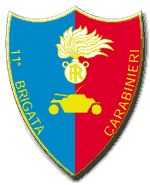
The 11th Carabinieri Mechanized Brigade was the Carabinieri formation, established in 1963 and disestablished in 2001, dedicated to the performance of military duties, the support to Territorial Organization, the participation in civil protection operations and to ensure the emergency reserve for the General Command.

